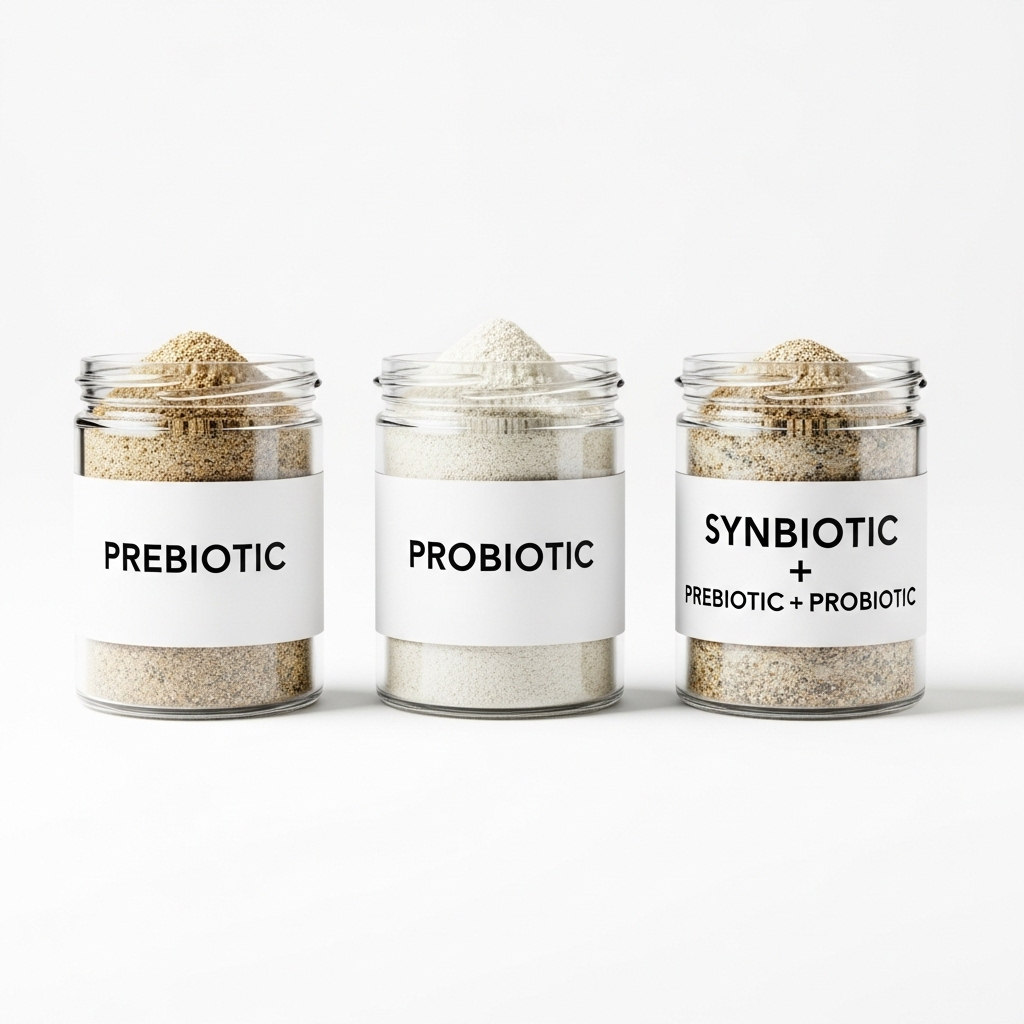Synbiotics vs Postbiotics for Pets: A Simple Guide

As a pet owner you may be seeing more products labeled “synbiotic” or “postbiotic” on pet food labels and supplement shelves. Both types are connected to gut health, but they are not the same. This guide explains, in plain language, what synbiotics and postbiotics are, how they work for dogs and cats, their potential benefits and risks, and practical tips for choosing and using them safely.
Quick definitions
Synbiotics = a combination of live beneficial microbes (probiotics) and the food those microbes need to grow (prebiotics). The goal is to deliver helpful bacteria plus nourishment to support them.
Postbiotics = non-living microbial products and compounds produced by beneficial bacteria (for example short-chain fatty acids, enzymes, peptides, and cell wall fragments). Postbiotics are not live organisms.
How they work in a pet’s gut
Both synbiotics and postbiotics aim to support gut function and the pet’s overall health by interacting with the intestinal environment and the immune system.
- Synbiotics introduce beneficial bacteria that can temporarily join the gut community and help maintain balance. The prebiotic component helps those strains thrive.
- Postbiotics deliver the bioactive molecules produced by microbes—these can influence gut lining health, inflammation, and local immunity without the need for living organisms.
Common components you might see
Synbiotic components
- Probiotics: strains such as Lactobacillus, Bifidobacterium, Enterococcus faecium, and certain Bacillus species (strain-specific effects vary).
- Prebiotics: fibers like fructo-oligosaccharides (FOS), mannan-oligosaccharides (MOS), inulin, and certain resistant starches that feed beneficial microbes.
Postbiotic examples
- Short-chain fatty acids (butyrate, acetate, propionate) that nourish colon cells and modulate inflammation.
- Bacterial metabolites, peptides, enzymes, and inactivated cell fragments that interact with immune receptors.
Potential benefits for pets
Research in animals and humans suggests potential advantages, though the strength of evidence and the specific benefits depend on strain, dose, and the individual pet.
- Improved stool quality and reduced diarrhea risk in some cases (particularly with certain probiotic strains).
- Support for a healthy intestinal barrier and local immune responses (postbiotics may help here even when live bacteria are less suitable).
- Combined synbiotics may be more effective than a probiotic alone when the prebiotic supports the specific probiotic strain.
- Postbiotics offer a more stable product (less temperature-sensitive) and avoid risks associated with live microbes in immunocompromised animals.
Synbiotics vs Postbiotics: When to choose which
There is no one-size-fits-all answer. Consider these general points:
- Choose synbiotics if you want live strains that can actively modulate gut flora and you have a product with proven strains and appropriate storage.
- Choose postbiotics if stability, shelf life, or safety with immune-compromised animals is a priority. Postbiotics can be useful when live microbes are not recommended.
- Some pet products combine approaches or are used sequentially—always follow your veterinarian’s guidance for chronic or serious conditions.
Safety, side effects, and interactions
Most healthy dogs and cats tolerate synbiotics and postbiotics well, but there are important considerations:
- Temporary mild gastrointestinal effects (gas, soft stool) can occur when starting a new supplement.
- Live probiotics may carry small risk of infection in severely ill, immunocompromised, or hospitalized pets—postbiotics avoid that risk because they are non-living.
- Give probiotics and antibiotics several hours apart; antibiotics can kill probiotic bacteria. Your vet can advise timing and whether a synbiotic is appropriate during antibiotic therapy.
- Quality matters: choose products that list strains, CFU (for probiotics), amounts of prebiotic, and clear storage/expiration instructions.
How to choose and use a product
- Talk to your veterinarian, especially for young, elderly, pregnant, sick, or immunocompromised pets.
- Look for strain-specific evidence: not all probiotics do the same thing. Trusted brands will list strain names and supporting research.
- Check storage: some probiotics require refrigeration, others are shelf-stable. Postbiotics are generally more stable.
- Follow dosing instructions on the label or from your vet. Don’t exceed recommended amounts without professional advice.
- Monitor your pet for changes in stool, appetite, or behavior and report concerning signs to your vet.
Pros and Cons
| Type | Pros | Cons |
|---|---|---|
| Synbiotics (probiotics + prebiotics) | May restore microbial balance, can improve stool consistency, prebiotic supports probiotic growth | Live strains can be less stable, may be risky in immunocompromised pets, benefits are strain-specific |
| Postbiotics (non-living microbial products) | Stable shelf life, lower infection risk, direct bioactive effects on gut cells and immunity | Less research on some products, won’t change live microbiome composition directly |
FAQ
- Are synbiotics and postbiotics safe for all pets?
- Most healthy pets tolerate them well, but pets with serious illness, compromised immunity, or on certain medications should be evaluated by a veterinarian before use.
- Can I give them during antibiotic treatment?
- Antibiotics can reduce the effectiveness of live probiotics. If using a synbiotic during antibiotics, space doses several hours apart and consult your vet. Postbiotics are less affected because they are not live.
- How long until I see results?
- Some pets show improvement in days (especially for mild digestive upset), while others may need 2–8 weeks. If there’s no improvement or if symptoms worsen, stop and talk to your vet.
- Can I give synbiotics and postbiotics together?
- In many cases they can be used together, but it’s best to follow product directions or your vet’s advice. Combining may be redundant in some situations depending on product formulations.
Key Takeaways
- Synbiotics = live beneficial microbes + prebiotic food to help them grow.
- Postbiotics = non-living microbial products and metabolites that can benefit the gut and immune system.
- Synbiotics may actively change gut microbiota; postbiotics provide stable, direct bioactive effects.
- Both can be useful for pets, but choice depends on pet health status, product quality, and veterinarian guidance.
- Always consult your veterinarian before starting supplements, especially for sick, young, pregnant, or immunocompromised animals.
Note: This article is for general informational purposes and does not replace veterinary advice tailored to your pet.
Disclaimer: The information provided here is educational and not a substitute for professional veterinary care. Always consult your veterinarian before giving supplements to your pet, and follow their recommendations for diagnosis and treatment of health conditions.

Leave a Reply